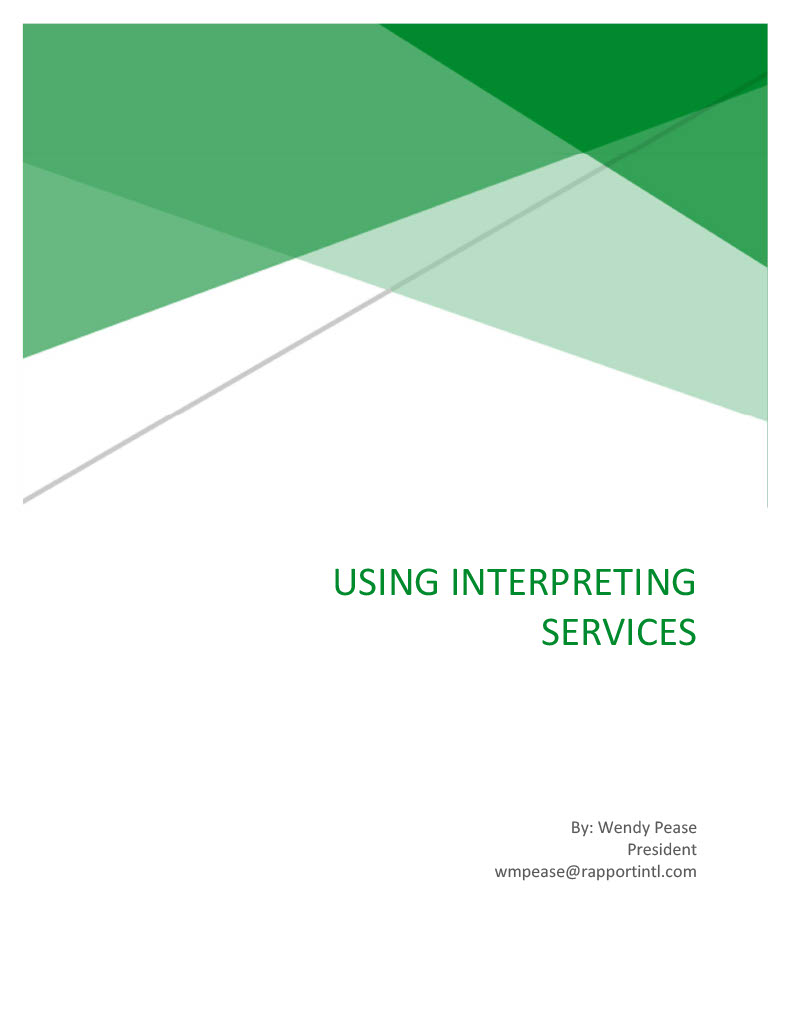Table of contents
Don't have to time to Read the Entire Guide Now?
Fill out the form for a downloadable PDF version of the guide you can reference later.
Interpretation is Fundamental
Doctor’s appointments, business meetings, school conferences, and legal proceedings are all part of a busy schedule. For most these meetings are routine, but for people who don’t speak the native language these interactions can be extremely difficult, causing stress, miscommunication, and even dangerous results. By hiring a language services agency and using a professional interpreter, you can eliminate these obstacles, improve customer satisfaction, and increase positive outcomes.

Types of Interpreting
When hosting a meeting, conference, or doctor’s appointment where there will be participants who speak different languages, it is important to provide an interpreter to facilitate the communication. In some cases, there are legal requirements to provide these services.
The terms interpretation and translation are not interchangeable. Translation refers to the conversion of written words from one language to another while interpretation is the conversion of the spoken word from one language to another. Every multilingual, interpersonal situation calls for a different style of interpreting and, as described below, each interaction comes with inherent, specific requirements. Likewise, interpreters specialize both in a particular style and industry, so always look for a high-quality language services provider who will pay special attention to properly matching interpreter and individual situation. Learn more about Rapport International’s Linguistic Matchmaking services.
Consecutive Interpreting
Consecutive interpreting is used when interpreting for individuals or small groups in situations such as a legal deposition, a doctor’s appointment, school appointment, or small business meeting. Each person talks and then pauses for the interpreter to repeat the information before the next participant begins. It is the conversion of the spoken word from one language to another, devoid of emotional context. Read more about best practices when working with an interpreter – How to Work Effectively with an Interpreter.
Video Remote Interpreting (VRI)
For in-person, one-on-one meetings where an interpreter does not need to be physically present, is not able to attend, or the meeting/discussion is anticipated to be short, video remote interpreting (VRI) services are a good option. The interpretation style will be consecutive, yet the interpreter will “attend” via a video call rather than being in the room with the meeting participants. VRI can be accessed with any device with a camera, a Wi-Fi connection, and the appropriate link. Read more about VRI in our blog "10 VRI Questions Answered."
Telephone Interpreting
Telephone interpreting is best for on-demand, immediate interpreting needs. This service allows you to call and request an interpreter in over 200 languages. Telephone interpreting is accessed with a telephone and an account number and is available any time of day or night. Telephone interpreters will also interpret in a consecutive manner, repeating what each participant says in the appropriate language. Learn more about telephone interpreting in our blog – Telephone Interpreting Services.
Simultaneous Interpreting
When there is a larger audience like at a presentation or seminar, or multiple languages are spoken by participants in the event, this typically calls for simultaneous interpreting, sometimes called conference interpreting. This is a skilled profession where the speaker does not pause for the interpreter; instead, the interpreter converts what the speaker is saying in real time.
Simultaneous interpreting requires a more demanding level of skill, and multiple interpreters are often needed in each language. For an ongoing session, the interpreter needs to process hearing and talking at the same time. Since this takes hyper-focus and can be taxing, interpreters in each language rotate every 15-20 minutes to combat fatigue. As an example of this, think of the UN with the delegates wearing headphones listening to an interpreter.
Virtual “Zoom” Interpreting
Recently, to meet needs presented by the pandemic, interpreting agencies have added services for live interpreters on video meetings via Zoom and other platforms. The interpreter can act as either a consecutive or simultaneous interpreter for these meetings, and if more than one language is needed, several interpreters can be scheduled for the same meeting. Read more about virtual interpreting in our blog – Qualified Interpreters for Virtual Meetings and Live Presentations.

The Role of an Interpreter
The purpose of an interpreter is to accurately convey your message to your audience. Whether you’re communicating with customers, negotiating with potential business partners, or speaking to employees, patients, or clients whose primary language is not English, clear, accurate communication is important.
Additionally, all federally funded organizations are legally required to provide interpreters, including the healthcare, legal, and educational systems. To conduct meetings such as medical appointments or parent/teacher conferences when English is not the primary language, skilled interpreters need to be included in the exchange of information.
Interpreters go through training to gain the skills needed to fulfill their purpose and learn how to expertly facilitate the conversation between participants. The role of a consecutive interpreter includes several key elements.
Conduit - An interpreter is there to convey the message with no additions, omissions, or embellishments. An experienced interpreter knows to interpret exactly word-for-word what is being said in the conversation.
Clarify - An interpreter can adjust or explain words that have no linguistic equivalent. Clarification is often needed when one of the parties does not understand the full meaning of what is being said. When needed, a professionally trained interpreter will clearly state that s/he is stepping out of their role to provide clarification or supporting information.
Culture Broker - A trained interpreter can provide cultural understanding. If there is something that one of the parties doesn’t understand, the interpreter can state that s/he is adding cultural context.
Advocate - An interpreter is an advocate to improve quality of communications. If the recipient doesn’t feel like they are understanding the material, the interpreter can share that information so that each party feels like they are connecting and communicating effectively.
Skills / Training of Interpreters
When organizations use untrained or unqualified interpreters, they can run into a number of problems. Risks to using friends and family or bilingual staff for interpreting services include lack of professionalism and confidentiality, losing the clarity of the message, and liability issues.
Professionalism & Confidentiality
Information is often confidential and should not be shared with friends and family or uninvolved staff members. HIPAA rules are very strict about medical information being shared. In one unfortunate example when a young family member was asked to interpret for the patient at a doctor’s appointment, the child did not translate the entire conversation in an effort to protect his grandparent from a grim medical diagnosis. The patient did not get the accurate information the doctor was conveying, and the child was put in an uncomfortable situation. A professional translator is taught to repeat each sentence word for word, even in emotional and difficult situations. They do not act as a filter.
Professional interpreters are also bound by confidentiality and code of ethics agreements and will not share anything they hear or see.
Clarity & Liability
Non-professional interpreters do not have the training to convey exact wording and may not know all the technical terms needed to communicate the conversation correctly. For example, a housekeeper was asked to translate for a patient because a professional interpreter was not called in. She told the patient that she needed stomach surgery. There was no problem with the patient’s stomach; what she needed was a routine pelvic exam. The housekeeper didn’t know the term used for the exam and didn’t feel comfortable questioning the doctor, so she took her best guess.
Situations where terms are interpreted incorrectly can not only cause confusion, but also lead to legal liability. See more on this below. And learn more about the Skills Needed to Provide Professional Interpreting Services in our blog.

Interpreter Training & Qualifications
Professional interpreters have a wealth of experience and training:
- All are fully bilingual, and most are native speakers.
- They have professional experience and/or education in their specialty fields – medical, legal, education, technical, etc.
- For medical interpreters, there are training and certification programs that include learning medical terminology, HIPAA rules, and other compliance guidelines.
- They participate in ongoing training and professional development courses to keep up with industry terms and best practices.
- All must understand and sign the National Code of Ethics, the National Standards of Practice, and an Interpreter Code of Conduct.
- Skilled interpreters are trained to provide the best possible service with the least possible intrusion.
Best Practices for Working with an Interpreter
Working with an interpreter can provide an exciting opportunity to reach new customers and connect with more clients, but it can also cause some apprehension. Your interactions with interpreters will go smoothly if you have time to prepare and know what to expect. To get the most out of your meeting or appointment, follow these guidelines to set you up for success and alert you to any potential warning signs or issues.
Positioning
Positioning is key to any interpreting situation. With consecutive interpreting, you want the interpreter to be sitting to the side and slightly behind the non-English speaking participant. Having the interested parties face each other helps build the relationship; they can maintain eye contact, see hand gestures, and understand body language. For example, at a school conference, the administrator or teacher is speaking directly to the parents with the interpreter in the background facilitating the conversation and not orchestrating it.
Positioning is also important so that the interpreter can signal the need to slow down or take a pause. In a virtual meeting, both the speaker and the interpreter keep their video on so they can see each other throughout the encounter.
Faithful Echo
The interpreter will echo the speaker’s words exactly as they are spoken. It is important that the participants speak directly to each other and in first person. At a doctor’s appointment, the doctor will speak to the patient, asking “How are you feeling?” and the patient replying, “I am feeling nauseous.” The interpreter will repeat “I am feeling nauseous,” not “He is feeling nauseous.”
Being a faithful echo includes repeating the exact words even when it includes volatile subject matter or swear words. While the interpreter will repeat the words, s/he will not include the emotion or hand gestures accompanying the words. The participants should be reading the emotion, body language, and hand gestures directly from each other – as they are looking directly at each other.
In delicate situations like a legal proceeding or human resources dispute where tensions may be high, it is important that the interpreter remain neutral, repeat exactly what is being said, and not express or convey emotions.
Speak Slowly & Relax
The speed at which you speak is important for working successfully with an interpreter. In consecutive interpreting, one person speaks, then pauses so that the interpreter can interpret before the next person continues the conversation.
You only want to give a little bit of information at a time, preferably one or two sentences, before stopping to let the interpreter repeat the information before moving on. This is also true if you are asking questions: you would ask one question, allow for the interpretation, allow for the answer, and then allow for the interpreter to repeat the answer back to you. It takes extra time, but the benefits of using a trained consecutive interpreter are well worth it.
No Gestures/Expressions
As mentioned in the Faithful Echo section, the interpreter will not repeat gestures or expressions. Conversational context clues are to be derived from the speaker, not the interpreter. In a Human Resources situation, the HR director will speak directly to the employee. Since both participants are facing each other, the employer can use body language, expressions, and gestures to determine the employee’s state of mind.
Addressing Issues
Occasionally, there may be a situation when working with an interpreter is not going well. This disconnect can often be rectified quickly with a few simple suggestions.
- If there seems to be extra talking going on, ask the interpreter to repeat exactly what is said and to stop engaging in side conversations
- If the interpreter can’t keep up with the amount of information you are relaying between pauses, speak in shorter sentences or phrases to break the information down into more easily relatable chunks.
- If you don’t feel like you’re building a relationship with the client, face the client so that you are the main point of facial connection and focus your attention on the client/patient.
- If all else fails and you still are having issues with the way the meeting is going, take a break to clarify your expectations with the interpreter and be clear about exactly what you expect. Explain what is not working for you and remember that you are in control of the situation.
Finally, contact the agency who provided the interpreter and give feedback as to what worked well and what didn’t work so they can address underlying issues and better train the interpreter for future assignments.
Legalities of Using Trained Interpreters
To comply with the law and avoid liability suits, federally funded and/or regulated organizations must provide interpreters. This includes medical, legal, employment, and community outreach situations. Working with a language services provider will help you understand your legal obligations and provide you with the resources you need to be compliant. The type of interpreter services needed will depend on the setting and, as mentioned above, should rely on linguistic matchmaking. Medical interpreters are specifically trained for healthcare-related settings, just as legal interpreters are trained for the court system.
Training Does Make a Difference
Using a friend, family member, or coworker as an interpreter does not comply with the law. You need to provide a professional interpreter to ensure that the information being communicated is accurate. Incorrect or incomplete information can lead to bad outcomes and possible lawsuits.
One unfortunate example is a medical malpractice suit for an 18-year-old baseball player who had passed out. The family used the word “intoxicado” which in Spanish means “ingested,” but the doctors assumed they meant “intoxicated” or “overdose.” Without a trained interpreter, the hospital staff treated the boy for a drug overdose. Days later, the staff figured out that the actual problem was bleeding in the brain, but by then it was too late. Because of the miscommunication, the patient was misdiagnosed, a neurosurgeon was not called in soon enough, and the patient suffered lasting damage and is now a quadriplegic. Clear language communication and more immediate access to specialized care could have made a huge difference in both the medical outcome and the legal ramifications.
Diversity, Equity & Inclusion
Mission statements often include a commitment to equity and inclusion. To successfully execute this mission, information and services should be provided in the recipient’s native language.
A company can only attract diverse employees if they can communicate effectively with them. Schools, hospitals, and community organizations can only offer diversity and inclusion if they provide their services in a variety of languages. Not only is it a good business decision, it is also legally necessary.
![]()
Buyer's Journey
A buyer’s journey is usually only thought to pertain to B2C or B2B sales cycles, but even if you’re not in that type of business you can use this mindset. Consider the buyer’s journey as the process any patient, client, or employee undertakes when engaging and interacting with your business.
In medical, legal, human resources, or community situations, it is helpful to think of your constituent as your “buyer” and lead them on a smooth journey to a successful outcome. This journey begins with their first phone call or visit and continues throughout their interactions with your organization.
All Interactions
From scheduling appointments to in-person visits, all points of contact need to provide language services for non-English speakers. There are a variety of ways to provide these services – in-person interpretation, video conferencing, telephone interpretation, translated documents, forms, pamphlets, and posters – all of which are great resources that will provide your client with the care and attention they require.
Language access can be made easy by providing “Point to your Language” cards, and “Know your Rights for a Free Interpreter” information. Many clients do not know they are entitled to a free interpreter and will unnecessarily bring a family member to interpret. You can also add telephone interpreting information to your staff’s phone contacts so everyone has easy access when needed.
For more information about phone interpreting, watch a video with our team member Nathan - Options for Speaking to Patients on the Phone who Don't Speak English.
Start Off Right
It is imperative that as the first point of contact, your receptionist or office assistant is equipped with the tools to make a good first impression. To avoid language mishaps, a receptionist can have a notecard at the front desk saying “Please wait a minute” translated into a variety of languages. They can then use a “point to your language” card and telephone interpreting service to have an interpreter on the phone in seconds to facilitate the initial conversation.
Note your client’s native language and keep a record from this first interaction so everyone knows the correct language for future use. This way, the information is easily available for everyone down the line. Also, make sure to schedule an interpreter for every encounter, even follow-up phone calls, referral information, and seemingly small details.
Don't Forget Written Materials
Consider all the information, pamphlets, posters, forms, and referral packets that you provide to your clients and think about which of these should be translated into multiple languages. Often there are items that can be translated once and then reused in multiple ways to save on cost and time.
Conclusion
There are many factors involved with hiring an interpreter for a small business meeting, legal proceeding, community outreach appointment, parent/teacher conference, or medical checkup. An experienced language translation company will help you determine your specific needs and provide you with realistic expectations. By using an agency, you are guaranteed the skills, training, and professionalism of a qualified interpreter. For your customers/clients/patients to have a successful outcome, you must provide the information and resources in their native language.
Rapport International specializes in multilingual communications, providing providing language translation and interpretation services that are accurate and culturally appropriate. We use the right voice and the correct terminology to avoid liability, customize services to your needs, and deliver on time and within your budget. With our 100% satisfaction guarantee, you can trust that it’s done right. Contact us today if you would like more information or to get a free quote.






